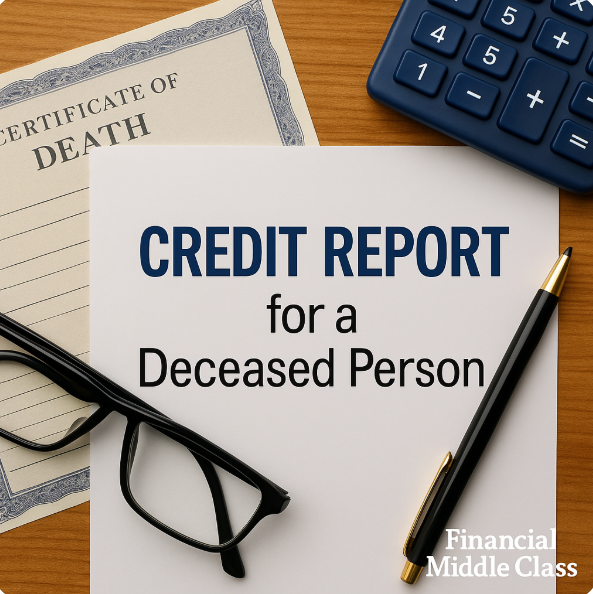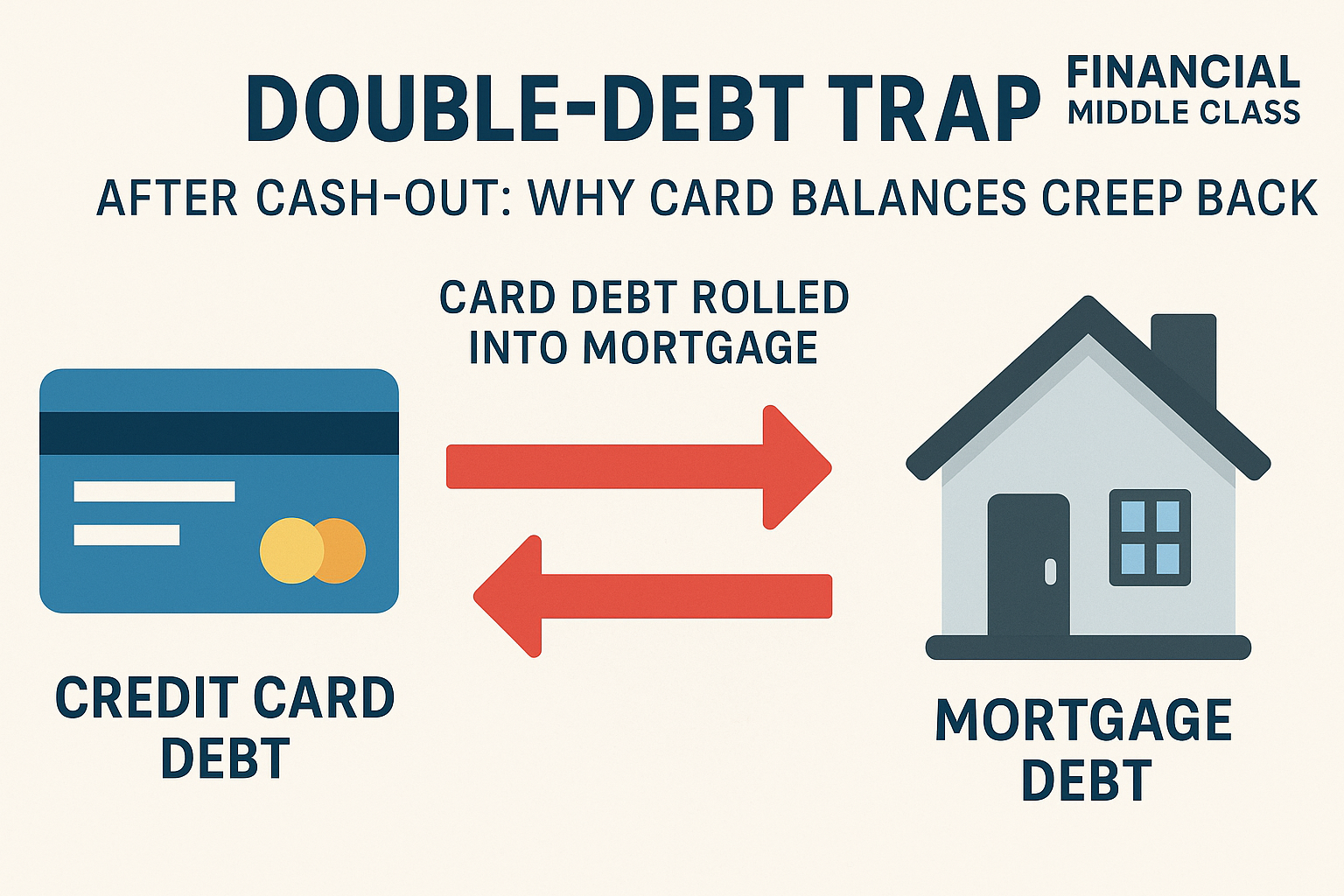
How to Pull a Credit Report for a Deceased Person (and What to Do With It)
By Article Posted by Staff Contributor
The estimated reading time for this post is 364 seconds
Credit bureaus allow a spouse or court-appointed personal representative/executor to request the decedent’s credit report by mail with proof (death certificate + proof of authority + your ID). That’s standard practice per the bureaus’ own instructions. See Experian, Equifax, and TransUnion guidance.
Why this matters now: Debt collectors may contact you; you have rights to verification, and most debts are paid (if at all) by the estate, not by you personally.
What You’ll Need (Before You Request Anything)
- Certified death certificate (copies).
- Proof you’re authorized (e.g., Letters Testamentary/Administration, or if you’re the surviving spouse, proof of marriage per bureau instructions).
- Your government ID and mailing address.
- Decedent info: full legal name, SSN, DOB, last addresses.
Where to Send the Requests (Big 3 Bureaus)
Mail copies—never originals—via certified mail with return receipt.
- Equifax
- P.O. Box 105139, Atlanta, GA 30348-5139.
- Experian
- P.O. Box 2002, Allen, TX 75013.
- TransUnion
- P.O. Box 2000, Chester, PA 19016.
Step-by-Step: Requesting the Deceased Person’s Credit Reports
Step 1: Gather documents (list above).
Step 2: Write your request (use the sample letter below). Ask for two things:
- A full consumer report for the decedent.
- A “Deceased—Do Not Issue Credit” flag to deter identity theft. (Some state consumer agencies recommend this phrasing.)
Step 3: Mail to all three bureaus (addresses above). Keep copies + USPS tracking.
Step 4: While you wait (1–3 weeks), reduce risk
- Forward or hold mail for the estate via USPS; only an authorized representative can do this.
- Stop marketing/junk mail addressed to the decedent via ANA’s Deceased Do Not Contact list (DMAchoice).
- Optionally opt out of prescreened credit offers (industry site OptOutPrescreen.com).
What to Look For When the Reports Arrive
- Open credit cards/lines: balances, autopays, authorized users.
- Installment loans (auto, personal) and mortgage tradelines.
- Unrecognized accounts or recent inquiries—could be identity theft. If you see it, move quickly with an FTC identity-theft report and dispute steps.
- Status codes: after bureaus process your death notification, tradelines will typically reflect a deceased indicator; Experian explains what happens to a file after death.
If Collectors Call You
Ask for a validation notice and written details. You generally don’t have to pay debts personally unless you’re a joint account holder/co-signer or state law says otherwise. Know your FDCPA rights.
Sample Letter: Request for Deceased Credit Report & “Do Not Issue Credit”
To: [Equifax/Experian/TransUnion – use addresses above]
From: [Your Name], Personal Representative of the Estate of [Decedent Name]
Date: [MM/DD/YYYY]
Re: Request for Credit Report of Deceased Consumer & Fraud Deterrent Notation
Dear [Bureau],
I am the [executor/personal representative/surviving spouse] of [Decedent Full Name, SSN last 4, DOB, last address], who passed away on [Date of Death].
Enclosed are: (1) a copy of the death certificate; (2) my proof of authority/relationship; and (3) my government-issued ID and mailing address.
Please:
- Provide a complete copy of [Decedent Name]’s credit report, and
- Place a “Deceased—Do Not Issue Credit” alert/notation on the file to prevent new credit from being opened.
Kindly confirm in writing once these actions are complete.
Sincerely,
[Your Name, Address, Phone, Email]
Enclosures: death certificate; proof of authority; ID; proof of address.
(That “Deceased—Do Not Issue Credit” language is recommended by some state consumer-protection agencies.)
Optional Script (Calling a Card Issuer to Close Accounts)
“Hi, I’m [Your Name], personal representative for [Decedent]. I’m calling to reach your Deceased Account Services/Estate Unit. I need to report the death, request closure of the account, and stop further charges. I can provide a death certificate and letters of authority. Please send written confirmation and final balance information to the estate’s address.” (Many issuers use dedicated estate lines.)
48-Hour, 2-Week, and 30-Day Checklists
Within 48 hours
- Secure the decedent’s wallet, mail, and devices.
- Put USPS mail controls in place (forward/hold).
- Register the DDNC to curb marketing mail.
Within 2 weeks
- Mail report requests to all three bureaus (keep receipts).
- List all known creditors (from mail, emails, and files).
- Prepare to contact lenders once the reports arrive.
Within 30 days of receiving reports
- Close credit cards; remove authorized users; stop autopays.
- Notify lenders on mortgages/auto/personal loans to align on next steps (payoff, assumption, or estate handling).
- If you spot identity theft, file at IdentityTheft.gov and follow the checklist.
Key Legal/Regulatory References (Plain-English)
- FCRA — Permissible Purposes (15 U.S.C. § 1681b): CRAs can furnish reports for specific, lawful purposes; in practice, bureaus accept estate reps/spouses with proof.
- FDCPA & CFPB guidance: Collectors must provide details and can’t misstate who owes; estates, not survivors, typically pay debts.
- Federal/Agency guidance on mail & privacy: USPS controls require proof of personal-representative status; opt-outs & DDNC help curb offers/mail.
Related Reads (Internal Links)
- Credit Reports After Death: What Surviving Family Members Should Know
- What Happens to Student Loans, Mortgages, and Car Loans After Death?
Call to Action
Get the reports, then take control. Close, convert, or dispute—one account at a time—and keep every confirmation letter.
Credit Reports After Death: What Surviving Family Members Should Know
Bottom line: The deceased person’s accounts don’t just vanish—they’re typically settled by the estate. Reports will eventually reflect a “deceased” indicator, and you’ll coordinate closures with lenders. Survivors aren’t automatically liable.
What Changes on the Credit File
- Deceased indicator: After the bureau processes notice + proof, the file is flagged as deceased; new credit shouldn’t be opened.
- Tradelines: Lenders may update accounts as closed due to death; joint accounts may remain active in the surviving joint holder’s name.
- Mistaken “deceased” flags: Contact the bureau (e.g., TransUnion lists a direct line) if a living consumer is misreported as deceased.
Who Owes What (High-level)
- Estate first. Debts are paid from estate assets during probate; if there’s not enough, many debts go unpaid.
- You may be liable if: you co-signed, were a joint (not authorized) cardholder, or state law says so.
After-Death Reporting: What to Do, In Order
- Notify bureaus and request reports (read: How to Pull a Credit Report for a Deceased Person).
- Audit accounts for balances, autopays, and suspicious activity (use FTC ID theft steps if needed).
- Close or convert:
- Individual credit cards: close via issuer’s estate unit.
- Authorized user cards: remove the user and close the card if the decedent was the primary.
- Joint accounts: the surviving joint holder typically continues responsibility.
- Document everything: save letters, validation notices, and payoff/closure confirmations (FDCPA requires debt validation).
Sample Script (Debt Collector Calls You)
“Please send a written validation notice with the creditor’s name, amount, and basis of the debt. I am not agreeing to pay. All further communication should be in writing to the Estate of [Name] at [address].
Mini-Checklist
- File the death notice with CRAs; request “Deceased—Do Not Issue Credit.”
- Review and close individual credit lines; remove AUs.
- Keep a ledger of balances due for probate.
- Dispute any identity-theft items via FTC and the CRAs.
Related Reads (Internal Links)
How to Pull a Credit Report for a Deceased Person
What Happens to Student Loans, Mortgages, and Car Loans After Death?
Call to Action
Don’t guess—verify. Mail the requests today, then use the reports to close accounts and protect the estate. Keep every letter and receipt.
RELATED ARTICLES
PMI Exit Plan: How to Remove PMI Faster and Reclaim Cash Flow
The estimated reading time for this post is 320 seconds PMI Exit Plan: How to Remove PMI and Reclaim Cash Flow Financial Middle Class | PMI Exit Plan – How to remove mortgage insurance faster and reclaim monthly cash flow....
The Double-Debt Trap After Cash-Out: Why Card Balances Creep Back
The estimated reading time for this post is 1163 seconds Home » Debt » Double-Debt Trap After Cash-Out The Double-Debt Trap After Cash-Out: Why Card Balances Creep Back Rolling card debt into your mortgage sounds smart, but it can trigger...
1 Comment
Leave Comment
Cancel reply

PMI Exit Plan: How to Remove PMI Faster and Reclaim Cash Flow

The Double-Debt Trap After Cash-Out: Why Card Balances Creep Back

Charitable Giving That Actually Helps (and Helps Your Taxes)
Gig Economy
American Middle Class / Nov 22, 2025
PMI Exit Plan: How to Remove PMI Faster and Reclaim Cash Flow
The estimated reading time for this post is 320 seconds PMI Exit Plan: How to Remove PMI and Reclaim Cash Flow Financial Middle Class | PMI...
By Article Posted by Staff Contributor
American Middle Class / Nov 21, 2025
The Double-Debt Trap After Cash-Out: Why Card Balances Creep Back
The estimated reading time for this post is 1163 seconds Home » Debt » Double-Debt Trap After Cash-Out The Double-Debt Trap After Cash-Out: Why Card Balances...
By Article Posted by Staff Contributor
American Middle Class / Nov 20, 2025
Charitable Giving That Actually Helps (and Helps Your Taxes)
The estimated reading time for this post is 697 seconds Charitable Giving That Actually Helps (and Helps Your Taxes) You’ve probably had this moment: you’re juggling...
By Article Posted by Staff Contributor
American Middle Class / Nov 20, 2025
Kid Magic on a Budget: Memory-First Traditions: Low-cost rituals that outlast the plastic toys forgotten by February
The estimated reading time for this post is 906 seconds Home › Family & Money › Kid Magic on a Budget Kid Magic on a Budget:...
By Article Posted by Staff Contributor
American Middle Class / Nov 20, 2025
Scams, “Limited Time” Pressure, and Fake Charity Drives
The estimated reading time for this post is 1364 seconds Scam Red Flags, “Limited Time” Pressure, and Fake Charity Drives A red-flag checklist and two-step verification...
By Article Posted by Staff Contributor
American Middle Class / Nov 19, 2025
Balancing Emotions and Money When the Holidays Hit Hard
The estimated reading time for this post is 1322 seconds Every year, somewhere between the first Christmas commercial and the last day of school before winter...
By MacKenzy Pierre
American Middle Class / Nov 19, 2025
New IRS Retirement Limits for 2026: Will You Actually Use Them?
The estimated reading time for this post is 756 seconds Americans can put more into 401(k)s, IRAs, and SIMPLE plans in 2026—and higher earners will see...
By Article Posted by Staff Contributor
American Middle Class / Nov 19, 2025
Behind on Your Mortgage? A Step-by-Step Guide to the Foreclosure Process
The estimated reading time for this post is 1060 seconds In October, lenders started the foreclosure process on more than 25,000 homes across the country —...
By Article Posted by Staff Contributor
American Middle Class / Nov 16, 2025
It’s Not About How Much You Make — It’s How Much You Keep
The estimated reading time for this post is 504 seconds Many Americans are earning more than ever, but far too many have almost nothing to show...
By Article Posted by Staff Contributor
American Middle Class / Nov 15, 2025
Portable Mortgages: Why the Middle Class Should Be Able to Take Their 3% Rate With Them
The estimated reading time for this post is 1209 seconds If you’re sitting on a 3% mortgage right now, congratulations — and I’m sorry. Congratulations, because...
By Article Posted by Staff Contributor
Latest Reviews
American Middle Class / Nov 22, 2025
PMI Exit Plan: How to Remove PMI Faster and Reclaim Cash Flow
The estimated reading time for this post is 320 seconds PMI Exit Plan: How to...
American Middle Class / Nov 21, 2025
The Double-Debt Trap After Cash-Out: Why Card Balances Creep Back
The estimated reading time for this post is 1163 seconds Home » Debt » Double-Debt...
American Middle Class / Nov 20, 2025
Charitable Giving That Actually Helps (and Helps Your Taxes)
The estimated reading time for this post is 697 seconds Charitable Giving That Actually Helps...




Pingback: Credit Reports After Death: What Families Should Know - FMC